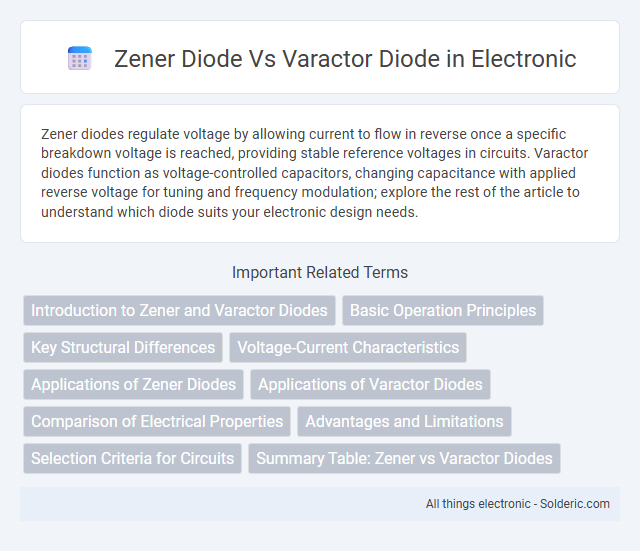Zener diodes regulate voltage by allowing current to flow in reverse once a specific breakdown voltage is reached, providing stable reference voltages in circuits. Varactor diodes function as voltage-controlled capacitors, changing capacitance with applied reverse voltage for tuning and frequency modulation; explore the rest of the article to understand which diode suits your electronic design needs.
Comparison Table
| Feature | Zener Diode | Varactor Diode |
|---|---|---|
| Primary Function | Voltage Regulation and Reference | Voltage-Controlled Capacitance (Tuning) |
| Operation Mode | Breakdown Region (Zener Effect) | Reverse Bias Variation |
| Key Characteristic | Maintains Constant Voltage | Capacitance Changes with Voltage |
| Applications | Voltage Stabilization, Surge Protection | RF Tuning, Voltage-Controlled Oscillators (VCOs) |
| Symbol | Two-terminal diode with a bent line and Z symbol | Diode symbol with variable capacitor indication |
| Biasing | Reverse biased to Zener breakdown voltage | Reverse biased, varying voltage to control capacitance |
| Physical Structure | PN junction designed for breakdown | PN junction with variable depletion region width |
| Voltage Range | Typically 2.4V to 200V | Varies widely based on design and application |
Introduction to Zener and Varactor Diodes
Zener diodes are designed to allow current to flow in the reverse direction when a specific breakdown voltage is reached, providing voltage regulation and protection in electronic circuits. Varactor diodes, also known as varicap diodes, function as voltage-controlled capacitors with capacitance varying based on the applied reverse bias voltage, commonly used in tuning and frequency modulation applications. Understanding the unique electrical characteristics of both Zener and Varactor diodes can enhance your circuit design by optimizing voltage control and signal tuning performance.
Basic Operation Principles
Zener diodes operate by allowing current to flow in the reverse direction once a specific breakdown voltage is reached, providing voltage regulation and voltage reference capabilities. Varactor diodes function by varying their capacitance with changes in the applied reverse voltage, making them essential in tuning circuits and voltage-controlled oscillators. Understanding these basic operating principles helps you select the correct diode type for voltage stabilization or frequency tuning applications.
Key Structural Differences
Zener diodes feature a heavily doped p-n junction designed to break down at a precise reverse voltage, enabling voltage regulation and protection in circuits. Varactor diodes have a lightly doped p-n junction that creates a voltage-dependent capacitance, used primarily in tuning and frequency control applications. Understanding these key structural differences helps you select the appropriate diode for voltage stabilization or frequency modulation needs.
Voltage-Current Characteristics
Zener diodes exhibit a sharp breakdown voltage where they maintain a nearly constant reverse voltage despite increases in current, making them ideal for voltage regulation applications. Varactor diodes, on the other hand, operate predominantly in the reverse-bias region with a nonlinear voltage-capacitance relationship and minimal current flow, as their current remains very low until breakdown occurs. The Zener diode's I-V curve shows a sharp increase in reverse current at the breakdown voltage, while the varactor diode's current stays negligible, emphasizing its use in tuning circuits rather than voltage stabilization.
Applications of Zener Diodes
Zener diodes are widely used for voltage regulation in power supplies, ensuring a stable output despite fluctuations in input voltage or load conditions. Their ability to operate in reverse breakdown allows them to protect sensitive electronic components from voltage spikes by acting as voltage clamps. These diodes are also essential in waveform clipping, reference voltage generation, and surge suppression circuits across various electronic devices.
Applications of Varactor Diodes
Varactor diodes are primarily used in voltage-controlled oscillators (VCOs), frequency modulators, and phase-locked loop (PLL) circuits due to their voltage-dependent capacitance. Their ability to electronically tune frequencies makes them essential components in RF design, including TV tuners, satellite receivers, and wireless communication systems. Unlike Zener diodes, which are used mainly for voltage regulation and protection, varactors enable dynamic frequency control in high-frequency applications.
Comparison of Electrical Properties
Zener diodes maintain a stable breakdown voltage, making them ideal for voltage regulation, while varactor diodes exhibit a voltage-dependent capacitance used in tuning circuits. The Zener diode operates primarily in the reverse breakdown region with a sharp knee voltage, whereas the varactor diode functions within the reverse bias region without reaching breakdown, providing capacitance variation with applied voltage. Your choice depends on whether you require voltage stabilization or voltage-controlled capacitance for your electronic applications.
Advantages and Limitations
Zener diodes provide stable voltage regulation with precise breakdown voltage, making them ideal for voltage reference and protection circuits, but their fixed voltage limits flexibility in tuning applications. Varactor diodes offer voltage-dependent capacitance used in frequency tuning and voltage-controlled oscillators, enabling dynamic adjustment, though their non-linear capacitance and sensitivity to noise can affect performance. While Zener diodes excel in voltage stabilization, varactor diodes are essential for responsive frequency control, each with specific trade-offs in application suitability.
Selection Criteria for Circuits
Zener diodes are ideal for voltage regulation and reference applications due to their precise breakdown voltage and stable operation under reverse bias. Varactor diodes are primarily selected for frequency tuning circuits, benefiting from their voltage-dependent capacitance, which enables efficient tuning in RF designs. Your choice hinges on whether voltage stabilization or reactive component variation is critical to your circuit's performance.
Summary Table: Zener vs Varactor Diodes
Zener diodes regulate voltage by allowing current to flow in reverse once a specific breakdown voltage is reached, commonly used for voltage stabilization. Varactor diodes function as voltage-dependent capacitors, varying capacitance with reverse bias voltage, ideal for tuning circuits like RF filters and oscillators. Your choice between Zener and Varactor diodes depends on whether voltage regulation or capacitance variation is required, highlighted in key parameters like breakdown voltage for Zener and capacitance range for Varactor diodes.
Zener diode vs Varactor diode Infographic

 solderic.com
solderic.com